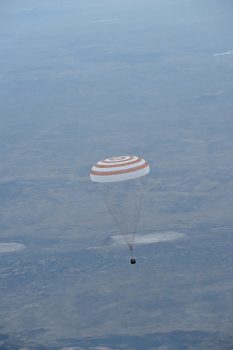
The Soyuz TMA-19M spacecraft has been waiting patiently for six months to return to Earth. Credits: ESA/NASA
Watch the return of ESA astronaut Tim Peake, NASA astronaut Tim Kopra and Soyuz spacecraft commander Yuri Malenchenko on Saturday, 18 June.
After 186 days in space for his Principia mission on the International Space Station, it is time for ESA astronaut Tim Peake to return to Earth. Watch live as Tim, commander Yuri Malenchenko and NASA’s Tim Kopra enter their Soyuz TMA-19M spacecraft, close the hatch to the Space Station, leave their home for the last six months and land in the steppe of Kazakhstan on Saturday.
The broadcast times are
| 02:15 GMT (04:15 CEST) | Farewells and hatch closing |
| 05:30 GMT (07:30 CEST) | Undocking |
| 08:00 GMT (10:00 CEST) | Reentry and landing |
Get updates via Twitter by following @esaoperations and on the Principia blog.
Expected timings (GMT)
| 05:51 | Undocking command |
| 05:52 | Separation |
| 05:55 | Thruster firing |
| 08:22 | Large deorbit burn for four minutes |
| 08:49 | Module separation 139 km above Earth |
| 09:00 | Parachute opens 10 km above Earth |
| 09:14 | Retrorockets fire an instant before touchdown |
A wild ride
Shortly after the deorbit burn, Soyuz separates into three parts. The orbital and service modules burn up on reentry in the denser layers of Earth’s atmosphere. The descent module turns to position its heatshield towards the direction of reentry, so that it can handle the 1600°C created by the friction with our atmosphere.
Reentry starts at an altitude of about 120 km, when their cruising speed of 28 800 km/h is reduced dramatically and the crew are pushed back into their seats with a force of 4–5 g. This is equivalent to four to five times their own body weight.
Parachutes reduce the speed further and the astronaut’s custom-fitted seats absorb the shock of landing. At the last moment, retrorockets fire to limit the impact to around 5 km/h.
After landing, the crew deploy a communication antenna for the rescue teams to pinpoint them, but search and rescue teams are often already onsite to retrieve the space voyagers.
Tim is the eighth ESA astronaut to complete a long-duration mission in space. He will be the third astronaut after Alexander Gerst and Andreas Mogensen to fly directly to ESA’s astronaut home base in Cologne, Germany, for checkups and to allow researchers to collect more data on how Tim’s body and mind have adapted to living in space.


Discussion: 14 comments
Safe trip Tim.
you have done a good job and interested so many people with your brilliant interactions. Congratulations.
Wishing the crew a safe trip back home. Thank you so much Tim Peake for all your updates, it’s been amazing to follow your stay at the ISS. Godspeed, Soyuz 🙂
Welcome home Tim , we in Britain are so proud of you x
Safe return Tim! Followed your amazing journey. Can’t wait to see you back on terra firma!
So Proud of all you represent Tim – Wishing you a Safe Return and every opportunity to share the Vast perspective our Earth and its peoples so desperately need….
Thank you for unravelling some of the mysteries of space and space travel in a way numpties like me can understand. Safe journey home.
Thank you Tim for doing such a wonderful job and sharing with us your experiences. I’ve truly enjoyed following your journey! Welcome home.
Safe journey home Tim a journey you will never forget thanks for all the brilliant photos can’t wait to here your story’s
Welcome home Tim
You have surpassed all expectations of our first UK astronauts “journey into space” your photographs have been eagerly awaited by the members of my group who have “loved” them all, given something of interest to brighten our life, something we would never have been able to see but for you. Many Many thanks and all our best wishes for your future ventures.
Welcome back Tim, Tim and Yuri. Congratulations on a safe descent and landing. Thanks, Tim Peake for keeping us so well-informed while you were on the ISS. So many people have been inspired by your adventures.
WOW…What a graceful touch down,WELCOME HOME Gentlemen,such an insperation to Research in our schools,enjoy your beer and curry,from THE KHADIJAH FAMILY.
Welcome home guys. Watched since 6am GMT absolutly facinating. Glad all went well and you all looked great x
Always smiling Tim Peake! Lovely to see him back on earth.